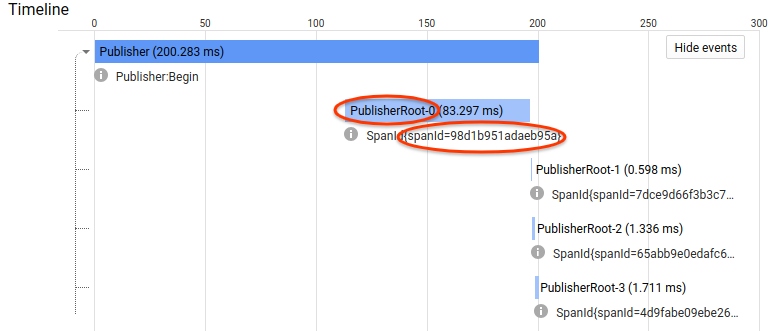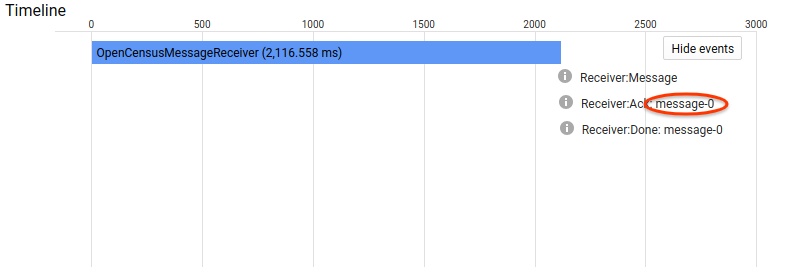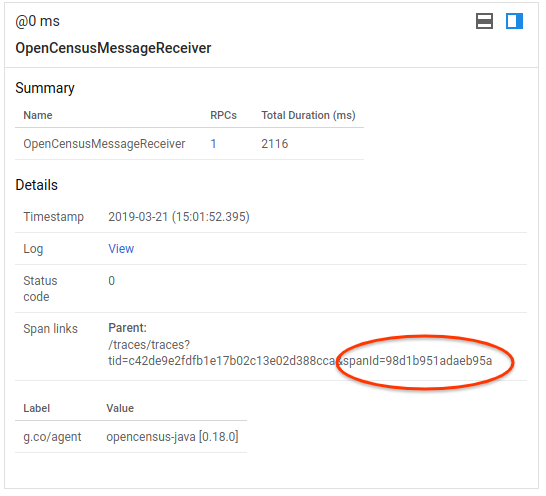Java

OpenCensus Tracing and Google Cloud Pub/Sub
Introduction
This article gives an overview of using OpenCensus Tracing with Google Cloud Pub/Sub illustrating that OpenCensus can be used for long-lived and asynchronous jobs.
Problem
Google’s Cloud Pub/Sub infrastructure provides a platform that allows publishers to send messages that are received by any number of interested subscribers. Many organizations use the Pub/Sub framework to implement loosely-coupled distributed systems such as batch processing systems. In such systems, when there are bottlenecks, it can be difficult to detect and pinpoint the source of these problems without observability.
OpenCensus tracing provides a framework for tracking down these kinds of problems for RPC systems (e.g. gRPC) that we have applied to work similarly with Cloud Pub/Sub.
The main differences main between RPC systems and Cloud Pub/Sub are that:
- Publishers don’t expect a reply from Subscribers
- Publishers can have thousands (or tens of thousands) of Subscribers, so a different approach is necessary to support this framework.
What you get
Following an approach similar to asynchronous RPCs, once OpenCensus is enabled in a Pub/Sub system:
- Publishers will have a trace span associated with their execution and this span will be implicitly propagated to Subscribers and
- Subscribers will process each message received as a parent link to the Publisher’s propagated span - these links will allow applications to see the end-to-end trace for the Pub/Sub system and enable them to debug performance anomalies.
Solution
Our approach for Cloud Pub/Sub is, on the Publisher side, we enable the implicit propagation of the current OpenCensus trace span when publishing a message. The trace span is passed as metadata with the message (via attributes) to the Subscriber, which ensures that it stays with the message even if the Pub/Sub system batches messages.
On the Subscriber side, each received message is executed in MessageReceiver,
an interface used to define handling of messages received from publishers. In
our solution, we provide the OpenCensusMessageReceiver, which will wrap any
MessageReceiver so that, when a message containing a propagated span is
received, it will:
- create a new root span for processing the message
- add the propagated span as a parent link to the new root span
- set the new root span as the current span and
- execute the original
MessageReceiverin that context.
In short, the original MessageReceiver will execute with a new root span that
has the publisher’s span as a parent link.
Alternative Solution
An alternative would be to create a child span in the Subscriber of the Publisher’s span. We don’t do this because 1. the lifetime of the publishing of the message and the receiving and processing of the message are not related (analogous to making an asynchronous rpc where the initial call will likely end before the rpc returns) and 2. publishers can potentially have tens of thousands of subscribers so having a trace with so many child spans would be unwieldy.
Example
Our example is based on the Pub/Sub Example Code in the Google Cloud Platform samples repository. We have modified the example by trace instrumenting it with OpenCensus —the complete example with our modified code is available here: Complete Modified Pub/Sub Example Code.
Publisher Changes
The relevant publisher code modifications are shown here and summarized below:
public static void main(String… args) throws Exception {
// topic id, eg. "my-topic"
String topicId = args[0];
int messageCount = Integer.parseInt(args[1]);
ProjectTopicName topicName = ProjectTopicName.of(
PROJECT_ID, topicId);
Publisher publisher = null;
List<ApiFuture<String>> futures = new ArrayList<>();
try (Scope scope = OpenCensusTraceUtil.createScopedSampledSpan("Publisher")) {
OpenCensusTraceUtil.addAnnotation("Publisher:Begin");
// Create a publisher instance with default settings bound
// to the topic.
publisher = Publisher
.newBuilder(topicName)
.setTransform(OpenCensusUtil.OPEN_CENSUS_MESSAGE_TRANSFORM)
.build();
for (int i = 0; i < messageCount; i++) {
try (Scope traceScope =
OpenCensusTraceUtil.createScopedSampledSpan(
"PublisherRoot-" + i)) {
OpenCensusTraceUtil.addAnnotation(
OpenCensusTraceUtil.getCurrentSpanIdAsString());
String message = "message-" + i;
// convert message to bytes
ByteString data = ByteString.copyFromUtf8(message);
PubsubMessage pubsubMessage = PubsubMessage.newBuilder()
.setData(data)
.build();
// Schedule a message to be published. Messages are
// automatically batched.
ApiFuture<String> future = publisher.publish(pubsubMessage);
futures.add(future);
}
}
} finally {
// Wait on any pending requests
List<String> messageIds = ApiFutures.allAsList(futures).get();
for (String messageId : messageIds) {
System.out.println(messageId);
}
if (publisher != null) {
// When finished with the publisher, shutdown to free
// up resources.
publisher.shutdown();
}
OpenCensusTraceUtil.addAnnotation("Publisher:End");
Thread.sleep(5000);
}
}The most important change in the code is augmenting the Publisher’s builder with:
.setTransform(OpenCensusUtil.OPENCENSUS_MESSAGE_TRANSFORM)which enables the implicit propagation of the current OpenCensus trace span when publishing a message. Strictly speaking, this code change is the only required change in the Publisher code. The other changes add OpenCensus instrumentation to the application to give more insight about what’s going on during execution.
The first code change is in the outer try-with-resources block:
try (Scope scope =
OpenCensusTraceUtil.createScopedSampledSpan("Publisher")) ...which creates a top-level parent span named ‘Publisher’ that is live for the
execution of the application (OpenCensusTraceUtil is a simple utility class
added to the example — details can be seen in the
Appendix). Because only sampled spans are propagated, for demo
purposes, we created a sampled parent span. However in standard applications,
please use the default sampling rate.
The next code change:
OpenCensusTraceUtil.addAnnotation("Publisher:Begin");adds an annotation to the parent span at the beginning of execution, before sending any messages (we’ll see this exported later).
The third code change:
try (Scope traceScope = OpenCensusTraceUtil.createScopedSampledSpan(
"PublisherRoot-" + i)) {adds a child span to our parent span for each message published — the child span is named PublisherRoot-i to make it easy to identify in the trace.
The next change is to add an annotation with the child span’s span id, which allows us to connect publisher spans and subscribers spans in the next section.
OpenCensusTraceUtil.addAnnotation(
OpenCensusTraceUtil.getCurrentSpanIdAsString());The final code change:
OpenCensusTraceUtil.addAnnotation("Publisher:End");adds an annotation to the parent span at the end of message processing.
Subscriber Changes
The relevant changes to the subscriber are shown here and summarized below:
static class MessageReceiverExample implements MessageReceiver {
@Override
public void receiveMessage(
PubsubMessage message, AckReplyConsumer consumer) {
OpenCensusTraceUtil.addAnnotation("Receiver:Message");
System.out.println("Message Id: " + message.getMessageId());
String data = message.getData().toStringUtf8();
System.out.println("Data: " + data);
OpenCensusTraceUtil.addAnnotation("Receiver:Ack: " + data);
consumer.ack();
OpenCensusTraceUtil.addAnnotation("Receiver:Done: " + data);
}
}
/** Receive messages over a subscription. */
public static void main(String... args) throws Exception {
// set subscriber id, eg. my-sub
String subscriptionId = args[0];
ProjectSubscriptionName subscriptionName =
ProjectSubscriptionName.of(PROJECT_ID, subscriptionId);
Subscriber subscriber = null;
try {
// create a subscriber bound to the asynchronous
// OpenCensus message receiver
MessageReceiver receiver =
new OpenCensusUtil.OpenCensusMessageReceiver(
new MessageReceiverExample());
subscriber =
Subscriber.newBuilder(subscriptionName, receiver).build();
subscriber.startAsync().awaitRunning();
// Continue to listen to messages
while (true) {
Thread.sleep(Long.MAX_VALUE);
}
} finally {
if (subscriber != null) {
subscriber.stopAsync();
}
}
}Once again, only one change is really necessary to the Subscriber code, the addition of:
new OpenCensusUtil.OpenCensusMessageReceiver(...)As previously described, the OpenCensusMessageReceiver will wrap the given
MessageReceiverExample so that it is executed in a new root span with the
propated publisher span set as a parent link.
In our example code, the user-defined MessageReceiverExample has been modified
in three places to add annotations to give insight into what’s going in the
code. Firstly, at the beginning:
OpenCensusTraceUtil.addAnnotation("Receiver:Message");Secondly, after processing the message and just before acknowledging it:
OpenCensusTraceUtil.addAnnotation("Receiver:Ack: " + data);and, finally, at the very end:
OpenCensusTraceUtil.addAnnotation("Receiver:Done: " + data);Note that, for this example, the data sent from the publisher is simple the string “message-i” where ‘i’ denotes the i-th message sent and corresponds to the publisher’s “PublisherRoot-i” span.
Running the Example
The example code provides a Publisher and a Subscriber. Following the original example code, we can execute the Publisher specifying how many messages to publish. In the following instance, we have the publisher publish 4 messages.
Publisher Trace
For the Publisher, we can see the parent span Publisher with Publisher:Begin
annotation and 4 child spans (PublisherRoot-0 … PublisherRoot-3). Each
child span has their span id added as an annotation. For PublisherRoot-0,
which sends message-0, the span id is 98d1b951adaeb95a:

Subscriber Trace (message-0)
For the Subscriber, if we look at the span for message-0:

we can see that the associated parent span link is also 98d1b951adaeb95a:

which matches the span id where message-0 was published, demonstrating that
the span context was propagated with the message and set as the parent link for
the span executing in the Subscriber.
Note that this matching based on span id is informal - for full validation we would also need to look at the trace id but we’ve simplified the matching here for demonstration purposes.
Caveats
We have shown how to use the OpenCensusUtil class in the Cloud Pub/Sub Java
library in order to generate traces connecting Publishers and Subscribers.
Caveat 1. OpenCensus Java is split into API and implementation. The Cloud Pub/Sub Java library only has a dependency on the API so, for Publishers and Subscribers to actually generate traces, a dependency on the OpenCensus implementation must be added — see
pom.xmlin the Appendix.Caveat 2. In order to export trace data to Stackdriver, the OpenCensus Stackdriver Exporter must also be linked into the application and initialized. See
OpenCensusTraceUtil.javaandpom.xmlin the Appendix for details.
Appendix
OpenCensusTraceUtil.java— utility class added to the Pub/Sub example. Note particularly the static initializer on line 28, which initializes the OpenCensus Stackdriver trace exporter.
class OpenCensusTraceUtil {
private static final Logger logger =
Logger.getLogger(OpenCensusTraceUtil.class.getName());
private static final String PROJECT_ID = ServiceOptions.getDefaultProjectId();
private static final Tracer tracer = io.opencensus.trace.Tracing.getTracer();
static void addAnnotationAndLog(String annotation) {
tracer.getCurrentSpan().addAnnotation(annotation);
logger.log(Level.INFO, annotation);
}
@MustBeClosed
static Scope createScopedSampledSpan(String name) {
return tracer
.spanBuilderWithExplicitParent(name, tracer.getCurrentSpan())
.setRecordEvents(true)
.setSampler(Samplers.alwaysSample())
.startScopedSpan();
}
static String getCurrentSpanIdAsString() {
return tracer.getCurrentSpan().getContext().getSpanId().toString();
}
static void logCurrentSpan() {
SpanContext ctxt = tracer.getCurrentSpan().getContext();
logger.log(Level.INFO, "OpenCensusTraceUtil: logCurrentSpan(): "
+ "traceid=" + ctxt.getTraceId().toLowerBase16()
+ "&spanid=" + ctxt.getSpanId().toLowerBase16()
+ "&traceopt=" + (ctxt.getTraceOptions().isSampled() ? "t&" : "f&"));
}
static {
if (!PROJECT_ID.isEmpty()) {
try {
// Initialize trace exporter.
StackdriverTraceExporter.createAndRegister(StackdriverTraceConfiguration
.builder().setProjectId(PROJECT_ID).build());
} catch (IOException exn) {
logger.log(
Level.INFO, "Initializing OpenCensusTraceUtil: Exception: " + exn);
}
}
}
}pom.xml— maven build file for the example. The necessary OpenCensus dependencies are delineated in the comments.
<project>
<modelVersion>4.0.0</modelVersion>
<groupId>com.example.pubsub</groupId>
<artifactId>pubsub-google-cloud-samples</artifactId>
<packaging>jar</packaging>
<properties>
<maven.compiler.target>1.8</maven.compiler.target>
<maven.compiler.source>1.8</maven.compiler.source>
<opencensus.version>0.18.0</opencensus.version>
</properties>
<dependencies>
<dependency>
<groupId>com.google.cloud</groupId>
<artifactId>google-cloud-pubsub</artifactId>
<version>1.62.1-SNAPSHOT</version>
</dependency>
<!-- [START opencensus_java_dependencies] -->
<dependency>
<groupId>io.opencensus</groupId>
<artifactId>opencensus-api</artifactId>
<version>${opencensus.version}</version>
</dependency>
<dependency>
<groupId>io.opencensus</groupId>
<artifactId>opencensus-impl</artifactId>
<version>${opencensus.version}</version>
<scope>runtime</scope>
</dependency>
<dependency>
<groupId>io.opencensus</groupId>
<artifactId>opencensus-exporter-trace-stackdriver</artifactId>
<version>${opencensus.version}</version>
</dependency>
<!-- [END opencensus_java_dependencies] -->
</dependencies>
</project>